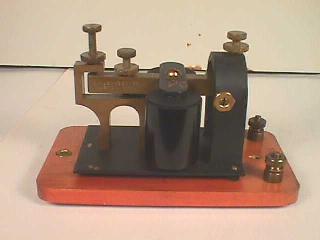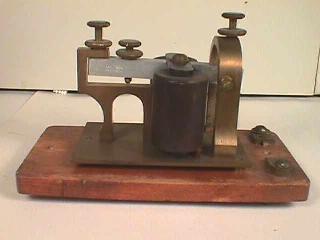Antique Telegraph & Apparatus
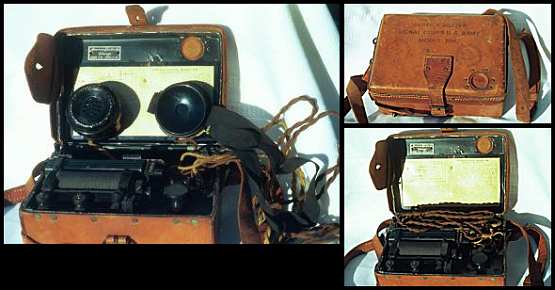
Stamped on top of the leather lid cover says: Service Buzzer Signal Corps
U.S. Army Model 1914, There is a one inch round hole with soft leather riveted on the top
lid cover so the unit can be used while closed. The operator could tap out the code through
this access hole. Inside the unit on the lid cover is stamped,
Stromberg-Carlson Tel. Mfg. Co.
Rochester N.Y.- U.S.A.
Order No 858 Year 1918
Also included on the inside of the cover is Form No 658 with general
instructions for use which carefully explains to the operator how to test and use this unit
along with a theoretical diagram.
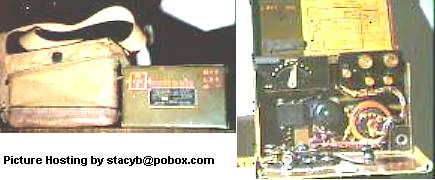
This is a Army Telegraph set TG-5A made by the Allen D. Cardwell Mfg.
Corp. Brooklyn, N.Y. It folds up into a case measuring 5" high, 7" wide
and 4" deep and comes int the army's designer olive green color. It's
dated May 1945. The top and front side fold open and the top has a
schematic diagram with the telegraph key mounted on the front panel. It's
in very good condition with the wiring and key looking like new. It has
the canvas and leather carrying case with a shoulder strap.
Western Electric Resonator & Sounder
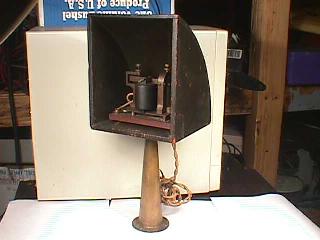
A resonator forms a cavity or reflecting surface which increases or
directs the clicking of a sounder and alters its tone. As used on railroads, the
local circuit sounder would be in the resonator, while the main line
calling sounders were mounted on an open shelf. Both railroad and commercial
operators positioned the resonator so it could be easily heard. To make
the tone of his sounder even more distinctive, an operator might wedge a
tobacco tin between the sounder stop standard and the back of the resonator.
Main Line Relay by J.H. Bunnell
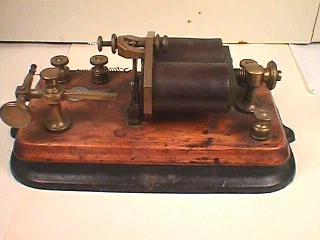
As the object of the relay is merely to "relay," or "repeat" the signals
passing over the main line to the "sounder" the play of its armature
should not be large. this play is regulated by moving forward or backward the
contact screw on the front stop (that is the screw next to the coils), and
the screw on the backstop. These relays may be "adjusted" in two ways;
either by drawing the cores away from the armature by means of the
adjusting screw which is attached to the cores suitably for that purpose, or by the
aid of the retractile spring attached to the armature. This piece has
solid Trunnion, Single Piece Armature.The Magnets wound with Enameled or Silk
Covered Wire, Polished Rubber Coil Covers, Mahogany Base, Mounted on
Ornamental Surbase, with Extension Adjustment. Their special advantages
consist in the armature and lever, which is all struck from a single piece
of iron. This piece has the metal nameplate and has the 150 Ohms
Resistance of the relay stamped on it and originally sold for $10.00
Ghegan Relay
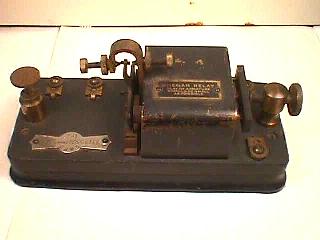
This Ghegan Relay is 250 Ohms and Mfg. by J.H. Bunnell. The metal plate
on the top reads Ghegan Relay play of armature should be small as possible.
Sounder
The object in using the "Sounder" in Morse telegraphy is to obtain an
increased sound as compared with that given out by the Morse relay. The
necessity for the sounder in Morse telegraphy in addition to the relay is
primarily due to the fact that the strength of current with a given
electromotive force is proportional to the resistance of the conductor;
the strength of current decreasing as the resistance increases. As the
resistance of wire of a given diameter increases directly with its length,
the longer the wire, the weaker will be the current. The magnestism
developed in a given electro-magnet, such as a relay, or sounder,
increases with the strength of current in the coils, and also with the number of
convolutions of wire in the coils; the resulting magnetism, being, within
certain limits, directly proportional to the product of the strength of
current multiplied by the convolutions of turns of wiire. This product is
termed the "ampere turns." It is found that, to produce the clear, loud
"click" of the ordinary Morse sounder, about one quarter of an ampere is
needed in its coils. It is unadvisable to attempt to supply sufficient
current to operate an instrument such as an ordinary sounder on long
telegraph lines. It is found more economical to employ a main line relay
having a much larger number of convolutions, and a light armature, not
designed to produce a large volume of sound, and then to cause this relay
to operate a sounder by means of a local battery.
Back






